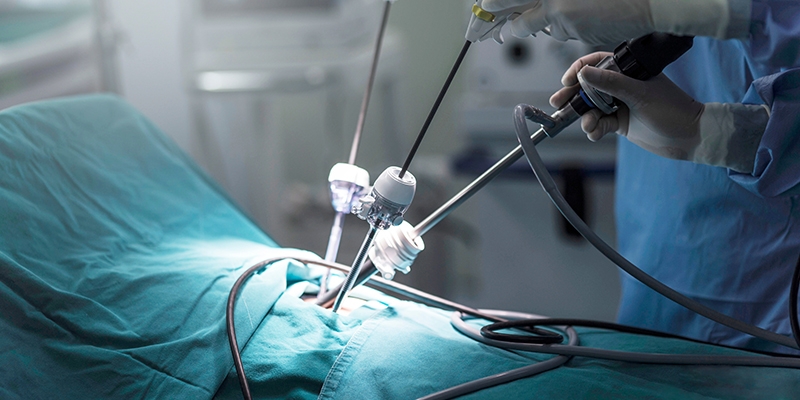Laparoscopic Salpingo-Oophorectomy is the minimally invasive procedure used to remove the ovaries or the fallopian tubes. The surgery to remove the ovaries and the fallopian tubes has been named Salpingo-Oophorectomy.
When a single ovary or fallopian tube is removed, it is called unilateral Salpingo -oophorectomy, and when both are removed, it is called bilateral Salpingo-Oophorectomy.
This procedure is carried out to treat conditions like ovarian cancer, explains Dr. Samrat Jhankar, who has carried out this surgery successfully and is known among the best gastroenterologists in Pune. The diagnosed woman was pregnant, thereby taking the risk of carrying out the surgery up a notch.
The doctor recommends this surgery in women who are probably at risk of developing ovarian cancer. There are instances when the doctor suggests removing healthy ovaries and fallopian tubes as a prevention measure.
The benefit of having this surgery is that it lowers the risk of breast cancer in women.


Why does one need to undergo Salpingo Oophorectomy?
As per Dr. Samrat Jhankar, you may require to undergo this procedure if your diagnosis shows any of the following problems:
- Endometriosis
- Ovarian cancer
- Ovarian torsion
- Benign or malignant cysts or tumors
- Ectopic pregnancy
- A pelvic infection.
A woman may also decide to undergo the procedure if she has tested positive for the BRCA gene mutation responsible for causing breast cancer and ovarian cancer.
You need to remember here that once you undergo the procedure, you may never conceive. So I think a consult with your gynecologist will clear up your possibilities before you make the decision.
What to expect when you undergo the Salpingo – Oophorectomy?
If you have to undergo Bilateral Salpingo-Oophorectomy, you need to know that you may not be able to conceive or get your periods.
An appointment with your fertility expert will clear up many of your doubts when it comes to your options of having a child is concerned.
The surgery will lead you to complete menopause. This will take its toll on your body in terms of loss of energy, depression, weight gain, bone loss, etc.
The procedure of Salpingo-Oophorectomy
The surgeon can carry out the surgery in any of the 3 ways:
The open abdomen surgery
This surgery requires you to go under general anesthesia. The surgeon will make an incision in your abdomen, dissect the ovaries and the fallopian tubes and suture back the abdomen together.
Laparoscopic surgery
The surgeon may choose to carry out this surgery by putting you in general anesthesia or local anesthesia based on the circumstances.
The surgeon makes a small incision and inserts the laparoscope inside your abdomen to visualize the approach.
The surgeon makes a few more small incisions to insert his tools to work on your ovaries and fallopian tube.
Robotic surgery
This procedure is also minimally invasive because the doctor uses a robotic arm instead of a laparoscope.
The robotic arm is a piece of technologically sophisticated equipment with high-definition vision and precision movements. The task is much easier. Once the surgeon removes your ovaries and fallopian tubes, he closes the incisions.
Postoperative precautions
Once your surgery is complete, you may be able to leave the hospital the next day unless it requires an open abdomen surgery.
The surgeon may cover the incisions with bandages that you can take out as per the doctor’s instructions.
Your surgeon will give you a set of instructions to follow before you are discharged from the hospital, which may include the following:
- Take the prescribed medication.
- Do not rub over the surgery wound; that means no ointments either.
- Take short walks now and then to avoid blood clotting.
- You are not to engage in any physically strenuous activity.
- There might be some vaginal discharge, but do not use tampons.
- Bathe with precautions
- Keep up with your follow-up appointment.
Minimally invasive surgery will allow you to return to a regular routine in a maximum of 3 weeks. An open abdomen surgery may take up to 6 weeks.
What are the adverse effects expected?
As such, the doctor explains it is safe surgery, but in rare cases, you may have one or more of the following side effects:
- Blood clots
- Urinary tract injury or other surrounding organs.
- Nerve damage
- Hernia
- Scar tissue formation
- Obstructed bowel
While these may not be visible to you, make it a point to meet the doctor if you observe the following:
- Redness, inflammation
- Fever
- abscess or open wound
- Increased abdominal pain
- Too much vaginal bleeding
- foul discharge
- vomiting
- discomfort
- breathing difficulties
- fainting
These point to infected wounds and can send you into septic shock.
Even if all of this goes well, in bilateral Salpingo-Oophorectomy, you may immediately observe menopausal symptoms like hot flashes, vaginal dryness sleeping difficulty, anxiety, and depression.
Conclusion
Even though the surgery itself is a not-so-complicated procedure, the effects of the surgery are something you will need help to cope with.
Physically your wound may heal in the stipulated time. Still, the lack of hormones will wreak havoc on mental and physical health in terms of continuous bone loss, depleted energy levels, and change in metabolism.
Please include your family or friend before going for surgery because you will need all the support you can garner. Your people will not be able to provide you with the kind of support you need if they do not know what to expect.
